| |






 |
|
"Twenty years ago, the genius of one man
brought to television a program that has transcended the medium. We are enormously pleased that that man, Gene Roddenberry, is going to do it again.
Just as public demand kept The Original Series on the air, this new series
is also a result of grassroots support for Gene and his vision." With those
words spoken by Mel Harris, the president of the Paramount Television Group,
the long-awaited second Star Trek television series at last became official
on October 10, 1986, seventeen years after the first series had been
canceled.
But this time there would be something
different in the revived series. The fight to bring back Kirk and his crew
that had been waged throughout the seventies was no longer a battle that
could be won. The Star Trek films and the individual careers of the key cast
members were too succesful for the original series' crew ever to be lured
back to the weekly grind of episodic television production. So with a grand
leap of faith, Paramount had agreed to the concept of setting the next
series a century ahead of the first, and going forward with an all-new cast
of characters.
 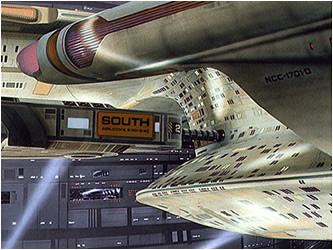
At the time, this attempt to "catching
light in a bottle," as Leonard Nimoy called it, carried considerably risk
for Paramount. The networks the studio had approached with the new series
had recognized that risk as well. Though all were interested in broadcasting
an updated Star Trek series, none was willing to commit to a full-season
order. At best, the networks would buy only six episodes. And the potential
revenue from only six episodes was not enough to cover Paramount's
investment in new sets, costumes, props and models.
Thus Paramount made the groundbreaking
decision to make the series directly for the syndicated market. It had been
in the syndicated market that the first series had found its audience, and
where it continued to thrive almost two decades later. Paramount executives
ran the numbers and determined that at the very worst, they would end up
with twenty-six new episodes, which they could add to the ongoing
syndication orders for the original seventy-nine. They could not be certain
if the series would succeed, but at least they knew the studio wouldn't lose
money.
With that critical business concern taken
care of, Gene Roddenberry once again began the task of gathering together a
production team that would match his passion for the Star Trek universe, and
take it boldly into its next century. In Star Trek: The Next Generation's
first season, its crew of veterans from the original series included
producer Robert Justman, William Ware Theiss as costume designer, set
decorator John Dwyer, and special-effects supervisor Dick Brownfield. And
this time, Roddenberry had his own second generation of Star Trek personnel
to draw from - veterans from the successful movies. In the first season,
these included makeup artist Werner Keppler, illustrators Andrew Probert and
Rick Sternbach, scenic artist Michael Okuda, and the visual-effects wizard
of Industrial Light & Magic.
Among the new faces added to the Star
Trek crew that year, production designer Herman Zimmerman, makeup supervisor
Michael Westmore, visual-effects coordinators Robert Legato and Dan Curry,
and unit production manager David Livingston would go on to make significant
and ongoing contributions to The Next Generation, as well as to the
following series and the next stage in the evolution of Star Trek movies.
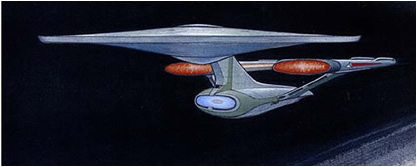
Andrew Probert was first hired by Gene Roddenberry in
1978 for Star Trek: The Motion Picture. However, not until 1986, when Roddenberry was preparing to launch
The Next Generation, did he call upon Probert to take a lead design role. Everything
had to be rethought, imagined, planned and redesigned. As the vision evolved
in the designers' minds, the evolution was charted in successive sketches
and paintings, some of which in elaborate and perfect detail are shown here.
 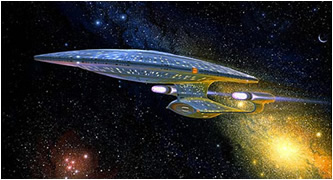
When it
came time to design a new starship Enterprise for The Next Generation,
history did not repeat itself. Where Matt Jefferies had produced hundreds
of sketches to come up with the design direction for the original
Enterprise, Andrew Probert's main design work for the new Enterprise was
done before his job even started.
Before the series was announced,
Andrew Probert painted the below illustration of a future starship concept,
strictly for his own enjoyment. When he went to work on the Paramount lot to
design the new Enterprise, he brought that painting with him as inspiration
and hung it on his office wall. One day, David Gerrold came into
Probert's office, saw the painting, and asked if Gene Roddenberry has seen
it. Probert said he hadn't, and Gerrold immediately took it in to
Roddenberry, who approved the painting's design direction on the spot. All
that remained was fine-tuning and filling in the details.
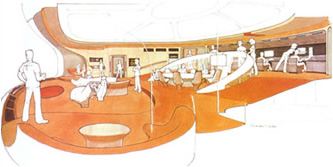
As well as many other sets, the
Enterprise's bridge had to be redesigned. These concept drawings
by Andrew Probert show the refinement of the new look
for the new bridge. An early writers' bible for the
new series described the new bridge as combining "the features of ship
control, briefing room, information retrieval area, and officers' wardroom.
In other words, much the same kinds of things happen here as in the old
bridge, but with less emphasis on the mechanics of steering the starship".
That new, less mechanistic approach
can be seen in the preliminary designs featuring viewing couches and a
conference table on the bridge.
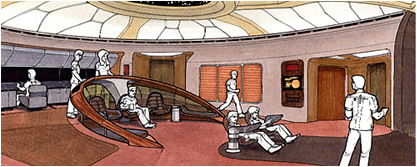
All material may be reproduced
under the Terms of Usage outlined in the legal
disclaimer. Simply stated, this means appropriate credit must be given in the form of a hyperlink.
For any content used by courtesy of a third party,
this third party is to be credited. |
|
|
 |
![]()